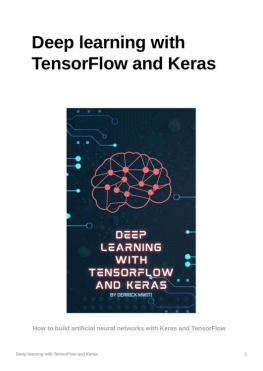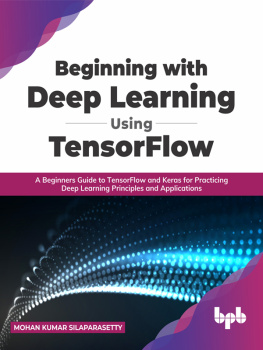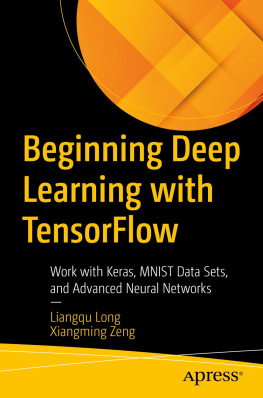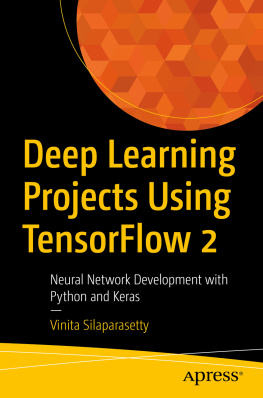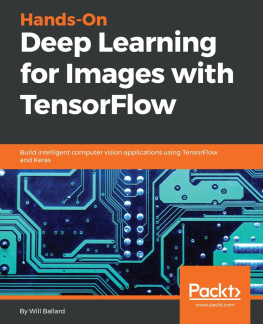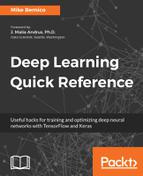Derrick mwiti - Deep learning with TensorFlow and Keras
Here you can read online Derrick mwiti - Deep learning with TensorFlow and Keras full text of the book (entire story) in english for free. Download pdf and epub, get meaning, cover and reviews about this ebook. year: 2022, publisher: leanpub.com, genre: Computer. Description of the work, (preface) as well as reviews are available. Best literature library LitArk.com created for fans of good reading and offers a wide selection of genres:
Romance novel
Science fiction
Adventure
Detective
Science
History
Home and family
Prose
Art
Politics
Computer
Non-fiction
Religion
Business
Children
Humor
Choose a favorite category and find really read worthwhile books. Enjoy immersion in the world of imagination, feel the emotions of the characters or learn something new for yourself, make an fascinating discovery.
- Book:Deep learning with TensorFlow and Keras
- Author:
- Publisher:leanpub.com
- Genre:
- Year:2022
- Rating:5 / 5
- Favourites:Add to favourites
- Your mark:
- 100
- 1
- 2
- 3
- 4
- 5
Deep learning with TensorFlow and Keras: summary, description and annotation
We offer to read an annotation, description, summary or preface (depends on what the author of the book "Deep learning with TensorFlow and Keras" wrote himself). If you haven't found the necessary information about the book — write in the comments, we will try to find it.
Deep learning with TensorFlow and Keras — read online for free the complete book (whole text) full work
Below is the text of the book, divided by pages. System saving the place of the last page read, allows you to conveniently read the book "Deep learning with TensorFlow and Keras" online for free, without having to search again every time where you left off. Put a bookmark, and you can go to the page where you finished reading at any time.
Font size:
Interval:
Bookmark:
 Deep learning withTensorFlow and Keras Deep learning with TensorFlow and Keras Deep learning with TensorFlow and Keras Deep learning with TensorFlow and Keras Deep learning with TensorFlow and Keras Deep learning with TensorFlow and Keras Deep learning with TensorFlow and Keras Deep learning with TensorFlow and Keras Deep learning with TensorFlow and Keras Deep learning with TensorFlow and Keras Deep learning with TensorFlow and Keras GitHub repo containing all the code https://github.com/mlnuggets/tensorflow How to build artificial neuralnetworks with Keras andTensorFlow Building artificial neural networks with TensorFlow and Keras requires understanding some key concepts. After learning these concepts, you'll install TensorFlow and start designing neural networks. This article will cover the concepts you need to comprehend to build neural networks in TensorFlow and Keras. Without further ado, let's get the ball rolling. What is deep learning? Deep learning with TensorFlow and Keras Deep learning is a branch of machine learning that involves building networks that try to mimic the working of the human brain. The dendrite in the human brain represents the input to the network, while the axion terminals represent the output.
Deep learning withTensorFlow and Keras Deep learning with TensorFlow and Keras Deep learning with TensorFlow and Keras Deep learning with TensorFlow and Keras Deep learning with TensorFlow and Keras Deep learning with TensorFlow and Keras Deep learning with TensorFlow and Keras Deep learning with TensorFlow and Keras Deep learning with TensorFlow and Keras Deep learning with TensorFlow and Keras Deep learning with TensorFlow and Keras GitHub repo containing all the code https://github.com/mlnuggets/tensorflow How to build artificial neuralnetworks with Keras andTensorFlow Building artificial neural networks with TensorFlow and Keras requires understanding some key concepts. After learning these concepts, you'll install TensorFlow and start designing neural networks. This article will cover the concepts you need to comprehend to build neural networks in TensorFlow and Keras. Without further ado, let's get the ball rolling. What is deep learning? Deep learning with TensorFlow and Keras Deep learning is a branch of machine learning that involves building networks that try to mimic the working of the human brain. The dendrite in the human brain represents the input to the network, while the axion terminals represent the output.
The cell is where computation would take place before we get the output. The image below shows a simple network with an input, hidden, and output layer. A network with multiple hidden layers is called a deep neural network. Deep learning with TensorFlow and Keras 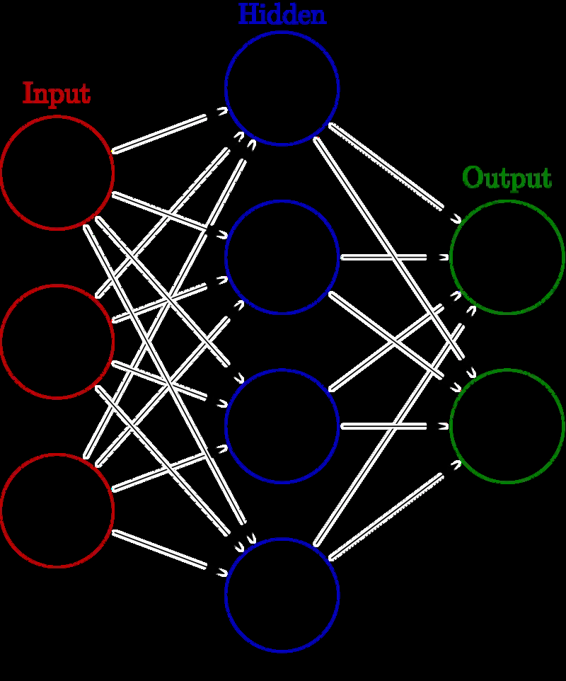 Random weights and biases are initialized when data is passed to a network. Some computation happens in the hidden layers leading to output. This computation involves multiplying the input by the weights and adding the bias.
Random weights and biases are initialized when data is passed to a network. Some computation happens in the hidden layers leading to output. This computation involves multiplying the input by the weights and adding the bias.
This is what gives the output. The bias ensures that there is no zero output in case the input and weights are zero. Deep learning with TensorFlow and Keras  There are various ways of initializing the weights and biases. The common ones include: Initialize with ones. Initialize with zeros. Use a uniform distribution.
There are various ways of initializing the weights and biases. The common ones include: Initialize with ones. Initialize with zeros. Use a uniform distribution.
Apply a normal distribution. What is an activation function? The desired output of a neural network depends on the problem being solved. For instance, in a regression problem, the output should be a number predicting the quantity in question. However, in classification problems, it's more desirable to output a probability that is used to determine the category of the prediction. Therefore, to make sure the network outputs the desired results, we pass the computed result through a function that ensures that the result is within a specific range. For example, for probabilities, this number is between 0 and 1.
We can't have negative probabilities. The function responsible for capping the result is known as an activation function. Deep learning with TensorFlow and Keras  From the above image, we can conclude that the activation function determines the neural network's output. Let's, therefore, mention some of the common activation functions in the deep learning realm. Sigmoid function The sigmoid activation function caps output to a number between 0 and 1 and is majorly used for binary classification tasks. Sigmoid is used where the classes are non-exclusive.
From the above image, we can conclude that the activation function determines the neural network's output. Let's, therefore, mention some of the common activation functions in the deep learning realm. Sigmoid function The sigmoid activation function caps output to a number between 0 and 1 and is majorly used for binary classification tasks. Sigmoid is used where the classes are non-exclusive.
For example, an image can have a car, a building, a tree, etc. Just because there is a car in the image doesnt mean a tree cant be in the picture. Use the sigmoid function when there is more than one correct answer. Softmax activation function The softmax activation function is a variant of the sigmoid function used in multi-class problems where labels are mutually exclusive. For example, a picture is either grayscale or color. Use the softmax activation when there is only one correct answer.
Deep learning with TensorFlow and Keras Rectified linear unit (ReLU) The Rectified linear unit (ReLU) activation function limits the output to 0 and above. It is used in the hidden layer of neural networks. It, therefore, ensures no negative outputs from the hidden layers. How does a neural networklearn? A neural network learns by evaluating predictions against the true values and adjusting the weights. The objective is to obtain the weights that minimize the error, also known as the lossfunction or cost function. The choice of a loss function, therefore, depends on the problem.
Classification tasks require classification loss functions, while regression problems require regression loss functions. As the network learns, the loss functions should decrease. You might see nans in the loss function while training the network. This means that the network is not learning. In most cases, nans will be developer errors, meaning that there is something you have done or failed to do that is causing the nans. For example: The training data contains nans.
You have not scaled the data. Performing operations that lead to nans, for example, division by zero or the square root of a negative number. Deep learning with TensorFlow and Keras Choosing the wrong optimizer function. Gradient descent We have just mentioned that choosing the wrong optimizer could result in nans. So what is an optimizer function? During the training process, errors are reduced by the optimizer function. Gradient descent adjusts the errors by reducing the cost function. Gradient descent adjusts the errors by reducing the cost function.
This is done by computing where the error is at its minimum, commonly known as the local minimum. You can think of this as descending on a slope where the goal is to get to the bottom of the hill, that is, the global minimum. This process involves computing the slope of a specific point on the "hill" via differentiation. Deep learning with TensorFlow and Keras 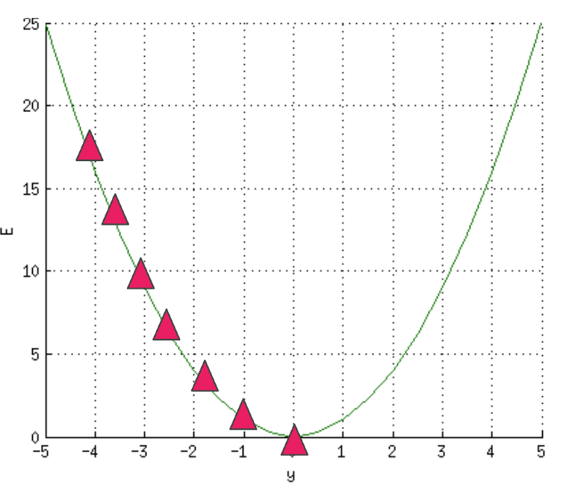 How backpropagation works The computed errors are passed to the network, and the weights are adjusted. This process is known as backpropagation. Deep learning with TensorFlow and Keras
How backpropagation works The computed errors are passed to the network, and the weights are adjusted. This process is known as backpropagation. Deep learning with TensorFlow and Keras  There are several variants of gradient descent.
There are several variants of gradient descent.
They include: Batch Gradient Descent that uses the entire dataset to compute the gradient of the cost function. It is slow since you have to compute the gradient of the entire dataset to perform a single update. Stochastic Gradient Descent where the gradient of the cost function is computed from a single training example in every iteration. It is faster. Mini-Batch Gradient Descent that uses a sample of the training data to compute the gradient of the cost function. Deep learning with TensorFlow and Keras What is TensorFlow?TensorFlow is an open-source deep learning framework that enables us to design and train deep learning networks.
TensorFlow can be installed from the Python Index via the pip command. TensorFlow is already installed on Google Colab. You will, therefore, not install it when working in this environment. # Requires the latest pip pip install --upgrade pip # Current stable release for CPU and GPU pip install tensorflow # Or try the preview build (unstable) pip install tf-nightly You can also install TensorFlow using Docker. Docker is the easiest way to install TensorFlow on Linux if GPU support is desired. docker pull tensorflow/tensorflow:latest # Download latest st able image docker run -it -p 8888:8888 tensorflow/tensorflow:latest-jupyt er # Start Jupyter server Follow these instructions to install TensorFlow on Apple arm64 machines.
Next pageFont size:
Interval:
Bookmark:
Similar books «Deep learning with TensorFlow and Keras»
Look at similar books to Deep learning with TensorFlow and Keras. We have selected literature similar in name and meaning in the hope of providing readers with more options to find new, interesting, not yet read works.
Discussion, reviews of the book Deep learning with TensorFlow and Keras and just readers' own opinions. Leave your comments, write what you think about the work, its meaning or the main characters. Specify what exactly you liked and what you didn't like, and why you think so.

